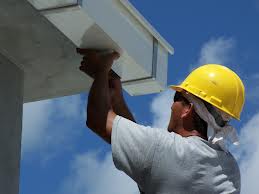Best Types of Gutters For Your Home
When it comes to taking care of your home and maintaining its value, gutters are an important yet underrated part of the protection package. There are several different types of gutters, but they all do essentially the same thing:
- Protect the home from water damage,
- Keep water away from the basement,
- Protect driveways, patios and sidewalks from erosion, and
- Protect your landscaping.
In addition, they help prevent moisture conditions that are conducive to termites, and properly designed gutters can protect against ice damming in cold climates.
Before 1960, most gutters were made of wood and metal, and they were (and still are) known as half round gutters because they were made in that shape. During the 1960s, rolled-form metal gutter technology allowed metal gutters to be made lighter and at a lower cost. There are two main types of gutter systems; sectional and seamless. Sectional gutters are considered easier to install, but are more likely to develop leaks.
Gutter materials have advanced over time, with roll-formed gutters now available in copper, aluminum, galvanized and painted steel. Vinyl snap-together gutters are often used in the DIY market because they’re easy to install (the tradeoff being increased possibility of leakage), while wood gutters can be made of either cedar or redwood.
There are three different types of gutters:
- K-style (also called formed Ogee or simply OG),
- Square box, and
- Half round
All gutter styles are usually sized according to the amount of roof area that must be drained. Five-inch wide, K-style gutters are the residential standard, with six-inch K style gutters used for  larger roofs. Half-rounds are typically sized one inch wider than K-style to provide the equivalent capacity.
larger roofs. Half-rounds are typically sized one inch wider than K-style to provide the equivalent capacity.
Leaders are basically downspouts that work together with gutters to collect rainwater from the roof and direct it away from the foundation, using leader extensions, splash blocks or underground drain lines. Leaders are typically rectangular, and leaders and gutters are normally made of the same material as the gutter to prevent destructive galvanic actions.
Leader diameters are usually sized according to the roof area of the building, with a 2 X 3 inch leader sufficient for 600 square feet and a 3 X 4 considered adequate for 1200 square feet. The typical leader size for a 5-inch K-style gutter is 2 X 3 inches, but a 3 X 4 is less likely to become clogged and is easier to clean out.
Leaders often need elbows to make turns around corners and under soffits, and gutter fasteners are usually required about every four feet, with two straps required for each leader. Concealed fasteners have become popular because they are easier to install.
The connection points between gutters, leaders and storm drains require ongoing maintenance to keep them free of leaves and debris and ensure the integrity of the connection. Some gutters offer filtration technology such as micro perforations that block large debris from sticking to the screen while efficiently clearing water into the gutters.
In addition, home centers offer a variety of gutter guards that can be installed on gutters to help keep debris out. Guards come in several different materials using slightly different designs, from slotted or perforated vinyl or metal extrusion to nylon mat filters. Snow guards should definitely be used in cold climates to prevent gutter tear off.
How much do gutters cost? To a large extent, it depends on geography and the choice of materials. Vinyl is the least expensive, and seamless vinyl gutters can be installed for as little as $3 a  foot in some areas. The approximate cost rises according to the cost of the material. Aluminium tends to run from $5-$15 per foot, steel from $16-25 per foot, and copper from $30-40 per foot. Guards can cost from $0.50 – $10 per foot depending on material and quality.
foot in some areas. The approximate cost rises according to the cost of the material. Aluminium tends to run from $5-$15 per foot, steel from $16-25 per foot, and copper from $30-40 per foot. Guards can cost from $0.50 – $10 per foot depending on material and quality.
The average residential home has 120-250 feet of gutters, so calculate accordingly. In addition, it can cost an extra $40-100 to haul away old gutters. Gutter contractors are the final part of the cost equation, typically adding $3-10 per foot to the installation cost. Two rules of thumb tend to apply: the more durable the material, the more difficult and expensive it is to install, and the cost of the installer will be about three times the price of the materials.
The added value that comes with using a contractor is expertise. A good contractor can help choose the best types of gutters for the home, and will also have trained installers as well as a knowledge of roof insulation and ventilation. To get the best possible contractor, look for four things:
- The best price,
- Good references from both clients and the local Better Business Bureau,
- A solid history with local construction companies and other similar professionals, and
- The ability to offer and install an appropriate array of materials.
